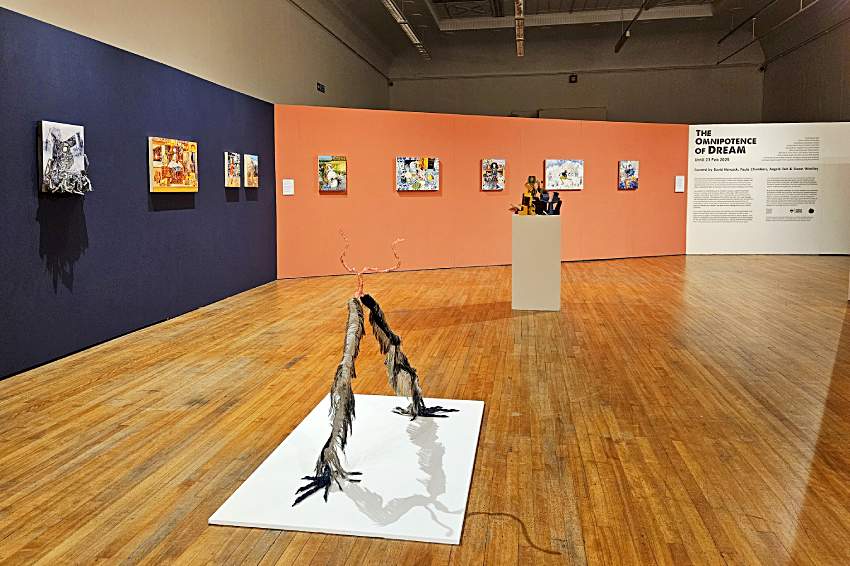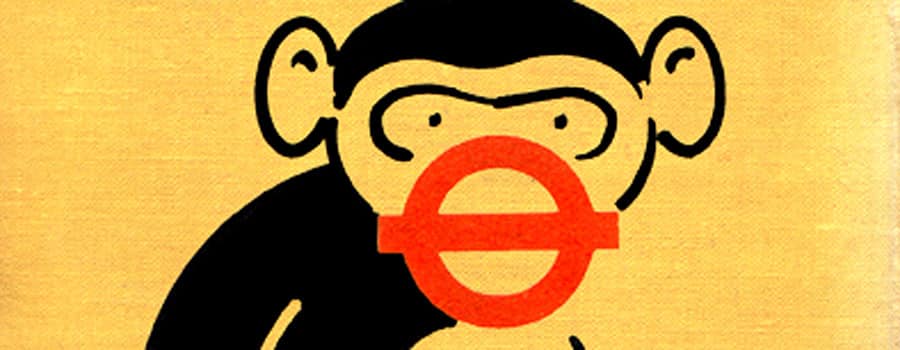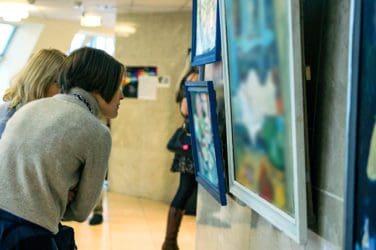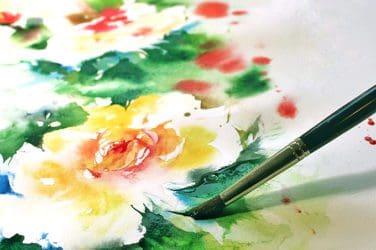Manchester based artist-curator and previous Visual Arts Editor of FLUX Magazine – Mike Chavez-Dawson (Rogue Artists’ Studios stalwart) reflects on the work of Artist David Hancock and talks to him about his highly ambitious, multi-layered and collaborative exhibition The Omnipotence of Dreams at Salford Art Museum & Art Gallery which is on until 23rd February 2025.
“What I want to show in my images is the beauty of failure.”
– Salvador Dalí
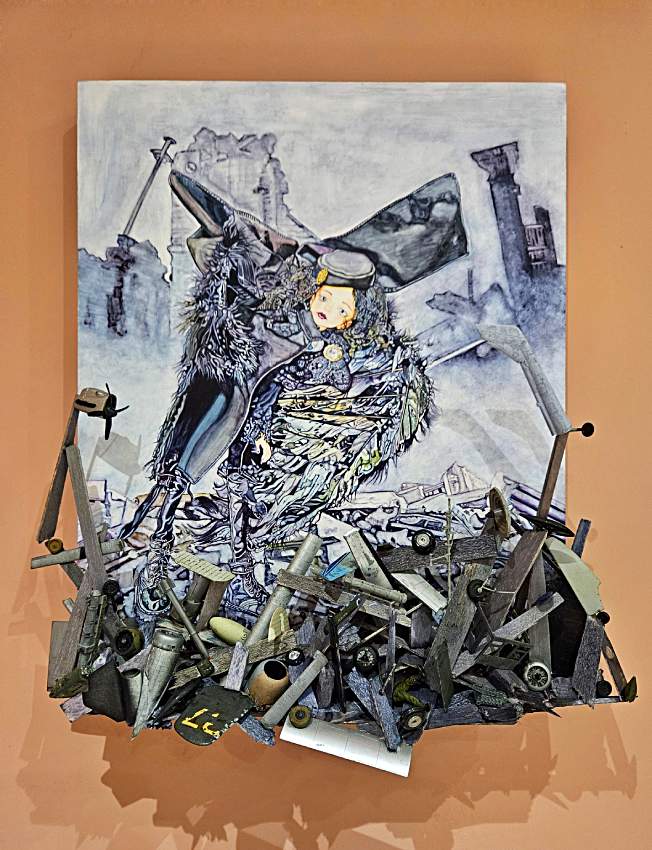
In order to challenge the conventions of beauty, the idea of ‘failure’ here is to celebrate the notion of those who may be considered marginalised – on the periphery of perceived convention – both in body, action & mind… one could align Dali’s sentiment to the long-established practice of Manchester/Salford based painter, academic and artist curator (co-founder of Paper Gallery, and The Fourdrinier) David Hancock, and his current show (The Omnipotence of Dreams at Salford Art Museum & Art Gallery, on until 23rd February 2025).
Hancock first came to prominence with his 1997 debut solo show Princess Leia was my first Kiss at Phillips Contemporary Art, Manchester, these saw Star Wars figures painted in acrylic on canvas in a photorealist manner, the figurine / doll – ‘action figure’ acting as a springboard for his wry flights of imagination, since then epic-bodies of works have proliferated… Focusing, on marginalised subcultures of Emo/Goths/Cyberpunks in The Beautiful People (circa lates 90s through to early 00s – a significant show debut at The Storey Gallery, Lancaster in 2003) these caught in the protagonists in the everyday of their lived lifestyles, a vast series saw Hancock’s’ construct multi-paneled panoramic canvas’s with some situated in corners, one such work featured in our Tracey Emin covered printed Flux Magazine (1999, issue 11) as a gatefold for FLUX SPACE (a gallery project in the printed publication), other bodies of work saw him reference the Pre-Raphaelites – a stunning piece titled ‘It’s too close to home and it’s too near the bone’ (2004) that took John Everett’s Millais 1851-1852 ‘Ophelia’ and gave it an angst inducing teenage twist.
Hancock has never shied away from reappraising arts’ histories, and whilst he has honed his articulation in the tradition of painting (initially acrylic, and now primarily in watercolour) – there’s a consistent critical dimension of analysis that is evident in both the content, and imagery portrayed – in his work.
Building upon this, additional bodies of other work such as his portrayal of the subgroup Cosplay(ers) – which was also the focus of his Doctorate, saw larger scaled watercolours with slight expanded gestural motifs with pools of the dripped/splattering process drawn upon alongside the photorealist discipline, prior to this he also created hyper-detailed monochromatic pencil & watercolour drawings of gamers caught in the midst of gaming elation, euphoria, and hypnotic states.
The works featured in this present show continues Hancock’s nod to past masters whilst building upon his modus operandi, but the works are more intentionally intimate and scaled down, drawing more upon the still life tradition with multiple vantage points/perspectives, though a few take on a playfully expanded dimension such as Harbinger (After Elizabeth Frink) – Watercolour on Gesso Panel with Airfix Models & Balsa Wood, (2024), this piece almost comes alive with its sculptural model components spewing forward.
And, to conclude my introduction – I’ll quote the existential poem of Surrealist founder Andre Breton, Less Time, “(less time), than it takes to say it, less tears than it takes to die; I’ve taken account of everything, there you have it…” and with that – let’s hear from David Hancock himself.
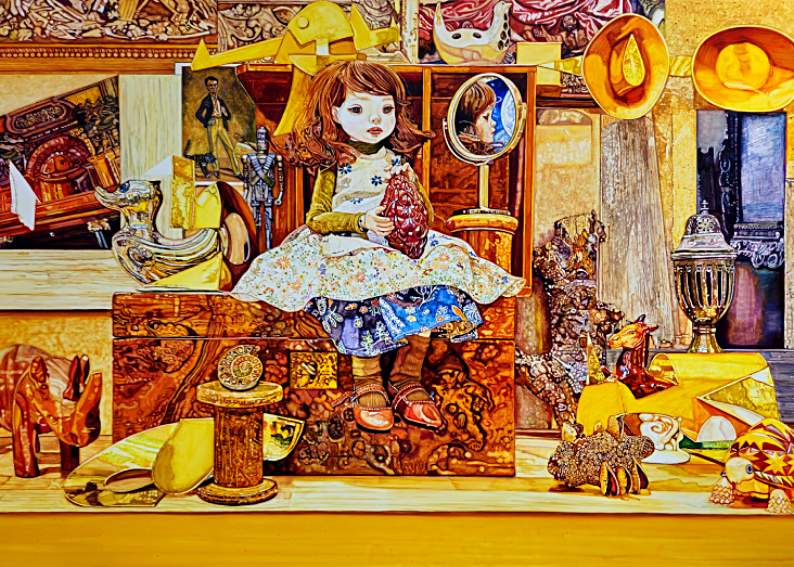
Mike Chavez-Dawson: What is the key aim of this ambitious show?
David Hancock: I think my aim for the exhibition is to explore how Breton’s vision of Surrealism remains a possibility. I believe Surrealism still offers a safe space for those on the margins to explore their identity through their art, and this is what the artists included in the exhibition have sought to do, and what I’ve been looking at in my own work as well.
MCD: So, in our current climate is ‘Surrealism’ is still relevant?
DH: The opening of the exhibition at Salford Museum & Art Gallery marked (almost to the day) the 100th anniversary since the Breton published his Manifesto of Surrealism. My hope for the show is that it offered an opportunity to reconsider the movement and its legacy. Surrealism is often viewed as homophobic and misogynistic, which makes the movement incredibly problematic, (though it seems not in America given the current election result). However, there is an interesting paradox with Surrealism, which is that the movement allowed more women to become prominent artists than any other movement of artists in Modern Art.
There were also several queer artists associated with Surrealism. I am keen to explore what drew women to this movement and it is my opinion that the female Surrealists were the true Surrealists or natural Surrealists, so their vision for Surrealism is one that is much more relevant today.
Though the exhibition, I wanted to re-examine Surrealism’s problematic past and the limitations that Breton established through a lack of inclusivity. Though Breton appears to be homophobic, his wife, Jacqueline Lamba was bi-sexual and Claude Cahun, a proto non-binary artist who was a close friend of Breton and a member of the movement. Breton was clearly enlightened in some respects, but struggled with his innate prejudices, particularly in relation to the theoretical aspects of Surrealism. So, Surrealism as a concept requires disentangling from the attitudes and practices of the Surrealists themselves.
MCD: The show is layered with lots of aspects, what was the rationale?
DH: I proposed the exhibition to Salford Museum & Art Gallery based upon their collection of Surrealist works, which I’d seen online. We went to view the works and discovered a wealth of Surrealist treats, several of which weren’t listed (such as the John Tunnard) and some that had never been exhibited before. We then made an initial list of artists who was keen to include and who were willing to make a response to one of the 6 works chosen from the collection. Working with Angela Tait, Dawn Woolley and Paula Chambers opened a wider list of artists and it was great to work with a number of artists who I’d never worked with before. The exhibition is split into three sections, firstly there is a solo exhibition of my work, which I’ve developed over the last few years, and draws from several Surrealist works, included those of the six Surrealist artists, Marion Adnams, Eileen Agar, Ann Fordham, Elisabeth Frink, Allan Milner and John Tunnard. Secondly, there is the group exhibition that pairs the 16 contemporary artists with the six works from the collection that has inspired them. The final section is a display of work from students from University of Salford and Leeds Arts University, who have similarly responded to a work of the six surrealist artists.
MCD: The doll (as a muse) and watercolours are central to your work, and to a certain degree the show, can you elaborate on this?
DH: The dolls are a recurring motif in my work. The doll is a ball-jointed doll, cast in resin, and part of a global subculture, originating in Japan. These dolls are usually purchased as blanks, and I will apply skin tones and make-up. The doll is both a self-portrait and a representation of the chosen artist. The doll is a non-binary, an avatar aligned to my own personality, tastes, and memories that allows me to navigate the still life assembled in the studio. The dolls are a form of drag and remain fluid throughout the painting. In this process, the doll becomes as ‘real’ as any human sitter and they offer a way for me to inhabit the painting both as the artist and subject.
I paint upon a smooth gessoed surface in watercolour, which doesn’t always adhere. It can be greasy, and the watercolour can pool in rivulets. The process is one of painting and removal, using wet wipes and cotton buds. The surface is incredibly fragile and can easily be wiped clean. This adds a tension, but also allows me to make wholesale changes as the work develops. Though I remain true to the still life in terms of proportions, I may fragment the still life and move objects around to sit better in the composition. In this way, the figures can also be situated in a surreal world constructed from assorted materials that shift between objects and imagery.
The Omnipotence of Dream
Curated by Paula Chambers, David Hancock, Angela Tait & Dawn Woolley
Featuring: Marion Adnams, Eileen Agar, Iain Andrews, Sally Barker, Jo Berry, Xanthe Burdett, Paula Chambers, Sarah Eyre, Ann Fordham, Elizabeth Frink, Carole Griffiths, David Hancock, Jeffrey Knopf, Alana Lake, David Leapman, Allan Milner, James Moore, Sean Powers, Olha Pryymak, Bethany Stead, Angela Tait, John Tunnard, Dawn Woolley + Passing Cloud Audio (AI Baby, Jo Manby, Xhi Ndubisi & Gary James Williams) + BA (Hons) Fine Art students from University of Salford & Leeds Arts University
Exhibition Dates: 19 October 2024 – 23 February 2025
Salford Museum & Art Gallery, Peel Park, The Crescent, Salford, M5 4WU
Relevant links:
https://salfordmuseum.com/event/dream/
https://www.thefourdrinier.com/audio-oct-2024-ai-baby-passing-cloud-x-the-omnipotence-of-dream
https://papergallery.myportfolio.com/the-omnipotence-of-dream


